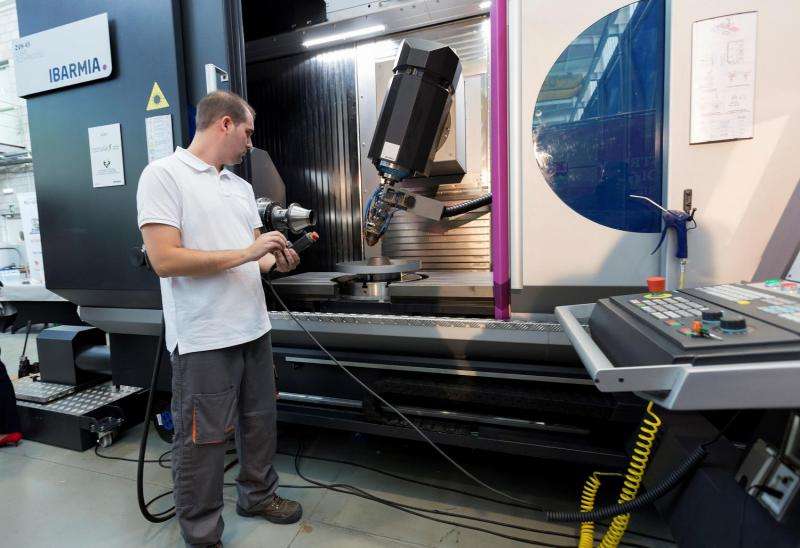Team showcases the biggest 3-D printing machine for industry

The Basque Autonomous Community is once again spearheading R&D&i applied to the industrial base to enable companies to be more competitive, not only by improving productivity but also by creating new products. The first machine to combine manufacture by means of 3-D printing and precision machining for Industry across the Spanish State is the result of the collaboration between the Basque machine-tool manufacturer Ibarmia, the University of the Basque Country and the Tecnalia research center.
This machine, known as ADD+PROCESS, is destined to revolutionise industry by opening up a broad range of possibilities for the world of design and manufacturing that is waiting to be discovered. It is a technology offering great potential and which has a long trajectory given that the machine becomes an autonomous production centre in which a finished part can be obtained from scratch. This machine is capable of manufacturing large-sized prototypes and parts of up to 1.6 metres long as well as repairing high-value parts for sectors such as the automotive, aircraft, oil & gas or machine-tool sectors.
To make this possible, the machine incorporates laser-based additive technologies and also allows large-scale parts to be milled and turned. Basically, it works by handling material on a micrometric scale and depositing it accurately until a solid has been built. So it replaces traditional processes that start with a block of material from which all the surplus part is removed by means of intensive machining until the desired part appears.
Compared with traditional technologies, additive technology uses the minimum amount of material, which leads to savings in terms of materials and energy of up to as much as 60% in some cases. What is more, handling the material on a micro-scale allows the current limits in design imposed by conventional manufacturing to be overcome by using parts with geometries, textures and details that would be impossible to manufacture using existing methods. This technology also constitutes a great advance, for example, when it comes to producing specific parts in sectors where safety is a critical factor, such as in aircraft manufacture.
An example of collaboration
This development is a clear example of the commitment of the 3 organisations involved owing to the RIS3 smart specialisation priorities of the Basque Autonomous Community, in this case, in advanced manufacturing. It is also a project that displays the benefits of collaboration among agents of knowledge, technology and the business sphere. It was in fact this collaboration that has enabled this machine to be made available on the market already and that an SME like IBARMIA has managed to get this tool off the ground within the space of just 9 months.
The ADD+PROCESS machine was showcased very successfully during the recent EMO fair in Milan and will be at the service of companies at TECNALIA's facilities in the Technology Park of Donostia-San Sebastian, where it will be possible to verify in situ its possible applications in different industrial sectors. It will also allow R&D&i tasks associated with improving additive manufacturing processes to be continued, the behaviour of the materials to be studied and the development of new applications to be explored.
This development project has the backing of the Government of the Basque Autonomous Community through the Basque Industry 4.0 programme being managed by SPRI (the Basque Autonomous Community's Business Development Agency) and the Spanish Ministry of the Economy and Competitiveness within its Retos-Colaboración 2015 tool.
Manufacture using 3D printing, the technology of the future
Manufacture by means of 3D printing or additive manufacturing (AM) figures in the list of the ten technologies with the greatest potential for improving our life quality, for transforming the production base and for contributing towards protecting the planet, according to the World Economic Forum, and everything seems to indicate that it is the technology that is set to change manufacturing processes in a whole host of fields and sectors of activity. It is also one of the key technologies supporting the Industry 4.0 strategy which is being worked on globally and for which the Basque Autonomous Community has been specifying its own itinerary.
As the very name suggests, additive manufacturing is the opposite of "subtractive" manufacturing, which is one of the traditional production methods: using a piece of material (wood, metal, stone, etc.) layers are gradually removed until the desired shape has been achieved. Additive manufacturing, on the other hand, starts with a material in the form of a thread or powder which is built up in a three-dimensional way by depositing this molten material using a digital model. 3D products can be tailored to the maximum for each end user, which does not happen with the manufacturing of large-scale products.
Provided by Elhuyar Fundazioa

















